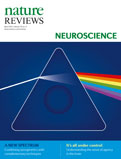|
Advertisement | |||||||||||||||||||||||||||||||||||||||||||||||
| |||||||||||||||||||||||||||||||||||||||||||||||
| TABLE OF CONTENTS | |||||||||||||||||||||||||||||||||||||||||||||||
| April 2017 Volume 18 Number 4 | Advertisement | ||||||||||||||||||||||||||||||||||||||||||||||
| In this issue
|
| |||||||||||||||||||||||||||||||||||||||||||||
| |||||||||||||||||||||||||||||||||||||||||||||||
 | |||||||||||||||||||||||||||||||||||||||||||||||
| Advertisement | |||||||||||||||||||||||||||||||||||||||||||||||
| |||||||||||||||||||||||||||||||||||||||||||||||
| |||||||||||||||||||||||||||||||||||||||||||||||
| REVIEWS | Top | ||||||||||||||||||||||||||||||||||||||||||||||
| Sense of agency in the human brain Patrick Haggard p196 | doi:10.1038/nrn.2017.14 The experience of controlling our own actions is an important feature of human mental life. The processes giving rise to this experience are thought to be disrupted in some psychiatric disorders. In this article, Haggard describes recent developments in our understanding of the cognitive processes and neural mechanisms underlying the sense of agency. Abstract | Full Text | PDF | |||||||||||||||||||||||||||||||||||||||||||||||
| Operation and plasticity of hippocampal CA3 circuits: implications for memory encoding Nelson Rebola, Mario Carta & Christophe Mulle p208 | doi:10.1038/nrn.2017.10 The circuitry of the hippocampal CA3 region has long been hypothesized to be well suited to the storage of memories. Mulle and colleagues provide an update on the known types and mechanisms of synaptic plasticity in CA3 and describe evidence for their roles in memory formation and retrieval. Abstract | Full Text | PDF | |||||||||||||||||||||||||||||||||||||||||||||||
| Integration of optogenetics with complementary methodologies in systems neuroscience Christina K. Kim, Avishek Adhikari & Karl Deisseroth p222 | doi:10.1038/nrn.2017.15 Optogenetics is widely used to study the consequences of neuronal activity with high spatiotemporal precision. In this Review, Kim et al. discuss the integration of this approach with other technological and methodological advances to gain insights into neuronal function that were previously inaccessible. Abstract | Full Text | PDF | Supplementary information | |||||||||||||||||||||||||||||||||||||||||||||||
| NMDA receptors: linking physiological output to biophysical operation Gary J. Iacobucci & Gabriela K. Popescu p236 | doi:10.1038/nrn.2017.24 Kinetic models of NMDA receptor activation derived from single-molecule observations explain the biologically salient features of the excitatory current as a dynamic sequence of quasi-stable receptor states. In this Review, Iacobucci and Popescu discuss how these models will help to match emerging atomic structures with biologically important functional states. Abstract | Full Text | PDF | |||||||||||||||||||||||||||||||||||||||||||||||
| PERSPECTIVES | Top | ||||||||||||||||||||||||||||||||||||||||||||||
| TIMELINE The two-century journey of Parkinson disease research Serge Przedborski p251 | doi:10.1038/nrn.2017.25 The year 2017 marks 200 years since James Parkinson's An Essay on the Shaking Palsy was published. In this Timeline article, Serge Przedborski provides an overview of the various avenues of research into Parkinson disease that have been pursued over these two centuries to better understand this neurodegenerative disorder. Abstract | Full Text | PDF | |||||||||||||||||||||||||||||||||||||||||||||||
| |||||||||||||||||||||||||||||||||||||||||||||||
You have been sent this Table of Contents Alert because you have opted in to receive it. You can change or discontinue your e-mail alerts at any time, by modifying your preferences on your nature.com account at: www.nature.com/myaccount For further technical assistance, please contact our registration department For print subscription enquiries, please contact our subscription department For other enquiries, please contact our feedback department Nature Publishing Group | One New York Plaza, Suite 4500 | New York | NY 10004-1562 | USA Nature Publishing Group's worldwide offices: Macmillan Publishers Limited is a company incorporated in England and Wales under company number 785998 and whose registered office is located at The Campus, 4 Crinan Street, London, N1 9XW. © 2017 Nature Publishing Group, a division of Macmillan Publishers Limited. All Rights Reserved. |
 |









No comments:
Post a Comment